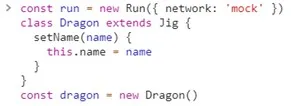|
Getting your Trinity Audio player ready...
|
Run is now in a public beta!
You can download the code at https://t.co/mzGo4fLTZt
Via NPM at: https://t.co/XxvC6TiEYM
Check out the Git repo at: https://t.co/52GYwqwKJ1
Join our now public run-sdk Slack channel at:https://t.co/KTvPeJYzVR
— runonbitcoin (@runonbitcoin) December 28, 2020
Run on Bitcoin is a platform where developers can build applications, tokens, and objects on Bitcoin SV. Until now, the SDK has been in a closed alpha where one must ask for permission to obtain the code, but now is finally open to the public. Despite this closed nature, Run has already seen significant adoption in the Bitcoin SV space for or over a year from companies like RelayX, TrueReviews (now Britevue), Kronoverse and DuckCreation.
Building interactive objects on BSV with Run could not be easier. Once the code is downloaded one can pop open a browser and create an NFT (Non-fungible token) with just a few lines of code:

What sets Run apart from other token standards is the SDK’s ease of use, extensive documentation, and interactivity. Much development in BSV is very niche and has a high barrier to entry whereas Run seeks to abstract the technical details away to entice beginner programmers (like HandCash Connect). Run still allows experienced developers to have great control if they choose with many advanced APIs. More details can be found in the docs.
Enabling new developers to build on top of the ledger is crucial if BSV is going to compete with other chains like Ethereum or EOS. Evangelism, shilling superior technical capabilities and just having lower fees have proven to simply not be enough in recruiting more builders. The arguments HandCash CEO Alex Agut have made in this regard are correct when it comes to reaching a wider audience.
An example on how to make Bitcoin optional, easy and valuable. @HandCashConnect just a few days away… pic.twitter.com/3nrjU9na2r
— Alex Agut (@apagut) November 13, 2020
Objects built on Run are called Jigs, and they can interact with each other. A Player Jig can equip Weapon and Armor Jigs and different Jigs can have dependencies on one another—for example, a Duck Jig can be implemented such that it can only be hatched from an Egg Jig. This is a primary focus of Run and a distinguishing feature from other BSV token protocols.
Run is widely known as a so-called ‘Layer 2’ token protocol that embeds metadata and transfer details into the OP_RETURN output of a Bitcoin transaction. That stated, Run really is more of a ‘Layer 1.5’ protocol since ownership of the objects is still UTXO-based. This means that unlike other Layer 2 standards like Tokenized, Run can fully leverage the power of Bitcoin Script.
— shua (@cryptoAcorns) December 21, 2020
Above is an example of mining a Run NFT on the BSV testnet with 21e8. Run also supports fungible tokens which RelayX have already implemented—USDC and OKBSV. With Run public, anyone can now launch their token on BSV.
Run does have some drawbacks however and one at the forefront is scalability. As discussed before, all token solutions face the ‘Back to Genesis’ issue in terms of validating a token’s history. Run is no different and requires external infrastructure to mitigate the performance issue.
Run is developed in 100% JavaScript. Some may find this a feature; others may find this as a bug. JavaScript remains atop lists of the most popular programming languages in 2020 though there definitely are more performant languages out there.
The choice to build Run in JavaScript is congruent with the low barrier to entry aspect of Bitcoin as anyone can start coding in the browser quickly without being required to download any IDE (integrated development environment).
Get started developing with Run today at https://run.network/.
Follow @runonbitcoin on Twitter and Twetch at u/21795.

 07-03-2025
07-03-2025 





